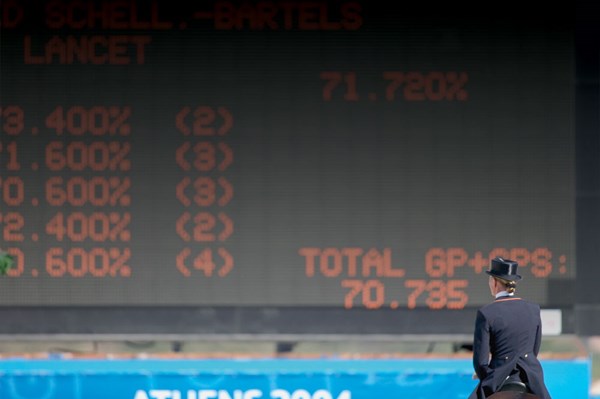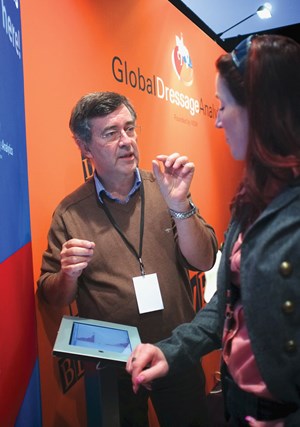
A particle physicist may seem an unlikely hero in the world of dressage, particularly one whose daily equestrian activity consists of watching his daughters ride and walking their ponies for them. But David Stickland, who works full-time in Switzerland at CERN—where the European Organization for Nuclear Research studies the fundamental structure of the universe with the world’s largest particle accelerator—has achieved what was previously considered impossible in dressage. He has found objective meaning in the subjectively determined marks given by judges. And with cofounders Akiko Yamazaki and the World Dressage Masters, Stickland created Global Dressage Analytics (GDA) in late 2011. His purpose is to share with riders, from Training Level to Grand Prix, the ability to give new meaning to the raw numerical data in dressage tests.
At the 2009 Global Dressage Forum in the Netherlands, Stickland made waves in the dressage world when he analyzed the scores from international championships and confirmed that biased and nationalistic judging did, in fact, happen. Riders and trainers were immediately intrigued while the judges were resistant to what appeared to be criticism from an outsider. One of the first to embrace Stickland’s approach was Yamazaki, who asked him to help Steffen Peters augment his preparations for the 2010 World Equestrian Games (WEG). Stickland agreed and began by analyzing Peters’ results. “What came out of the analysis was that Steffen’s pirouettes were the problem,” Stickland remembers. “He knew they were a weakness; he’s an intelligent rider. But he had not put it together that the pirouettes were the critical element.” The analysis was made purely on the detailed score sheets from competitions. “I had not seen Ravel live. I didn’t study video; there was no point because I’m not a judge.” As things turned out, Peters went home with two individual bronze medals at that WEG.

Leading up to the 2012 Olympics, Stickland worked with all three medal-winning dressage teams in their preparations for London. “I worked with the Germans and the Dutch in a similar way,” says Stickland. “I followed all the riders who had potential to make the team.” He particularly remembers one meeting in Amsterdam with the Dutch team hopefuls. He was seated at a table with that country’s stars, including Adelinde Cornelissen, Anky Van Grunsven and Edward Gal. “I’m sitting there talking about what Adelinde could improve in her test and I’m thinking, This is surreal. I’m sitting with these superb riders, and I can’t ride a Third Level test respectably anymore. It was a lot of fun.”
Stickland came into the program for the eventual gold-medal British team at a later date and worked only with the British Equestrian Federation rather than with individual riders.
Stickland’s GDA online program has the capacity to accept scores from all Fédération Equestre Internationale (FEI) tests (including Para-Dressage) as well as all U.S. Equestrian Federation (USEF) tests from Training through Fourth Level. He wants data so there is no charge (globaldressageanalytics.com). He says the decision to offer basic data-collecting and analysis free of charge was motivated by the fact that to be reliable all statistical analysis depends on as large a set of data as possible. “It’s more important to get people involved and data coming in so we can start to understand it better and provide meaningful feedback to a rider,” he says.
Confidentiality has been an important issue for the fledgling enterprise. “I can make it possible for riders to share results if they want to, but the program is totally confidential,” Since the GDA data reveals trends in addition to raw results, Stickland believes confidentiality is of utmost importance: “We look at what is getting better and worse. That should not be public information.”
Stickland’s analysis has applications for judges as well. Most lower-level national tests have only a single judge, but GDA has the means to determine how consistent a single judge is by comparing multiple results of a single rider with other judges. The initial resistance Stickland experienced from the judges when he first began to analyze results has faded, at least within the international judging community. “When confidence levels are high, people are going to be more open-minded.”
Talent identification is another application Stickland has begun to roll out with several countries, including the United States. “There are a limited number of people at the top, and everyone knows them,” he says. But particularly in a country as geographically large as the United States, “It’s really important to know what’s happening in every corner of the country, but you can’t go to all those events.” Data stored by GDA would provide information about a rider or horse in any part of the country who is showing potential.
Although he has no plans to quit his day job at CERN, Stickland does have many plans for the future of GDA. “Coming out of last year, I felt personally proud and satisfied about the things that have gone well with GDA,” he says. He sees that many riders at the lower levels are discouraged by inconsistent results. “I find it really useful to get people to find the positive side of things.”
Stickland says he would describe his interest in dressage as a fixation. “My family is really nice and they accept the fact that I find a table of numbers an interesting thing to do after dinner. What I do is try to find meaning in the numbers. I really like to see whether I can find patterns and to then look for what is behind those patterns.” Not many people are as interested in numbers as Stickland is, but every person who enters at A or sits in a judge’s booth can benefit from his analysis.
Stickland’s Inspiration

David Stickland, a British physicist, clearly remembers the moment he first started to take a keen interest in dressage scores: when his daughter, Clarissa, competed in her first dressage test at the age of 7. “My daughter came both first and last in the scoring of the two judges,” he says. He and his wife, Lyn, a dressage trainer and certified riding instructor, talked to their daughter about receiving such divergent results. The experience exposed Stickland to one of the more frustrating realities of competitive dressage. “I think a lot of people get discouraged by dressage at that level,” he says. “It doesn’t look like it makes sense.”
Following that experience, Stickland began to look at the scores in a new light. Later, when his daughter competed in the FEI Pony division, she reached a plateau in the 62-percent range that fell short of her goals. Her father took her score sheets and analyzed them. He sat her down and showed Clarissa that over a period of time she could achieve 6.5 to 7 in every single movement. It was not one individual exercise that was keeping her score low. The problem was that she was always having one or two movements go poorly in a competition. No single movement was a consistent weakness. Showing her that if she performed every movement to her potential she could score 66 percent gave her confidence that she could achieve the result she wanted, and she did just that a few weeks later.











